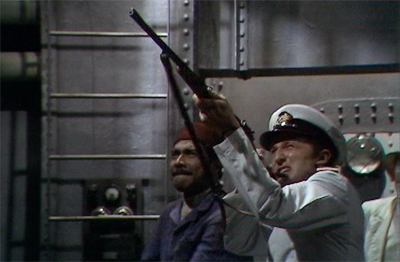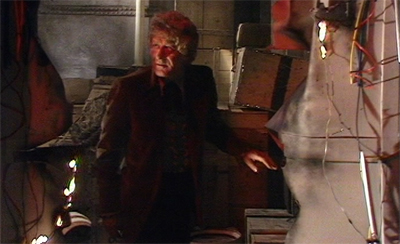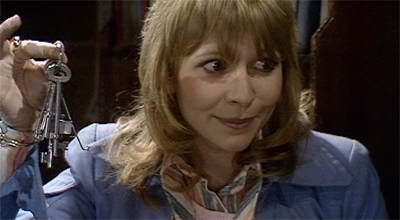To celebrate the fiftieth anniversary of the longest-running science-fiction show in the world, I’ll be taking weekly looks at some of my own personal favourite stories and arcs, from the old and new series, with a view to encapsulating the sublime, the clever and the fiendishly odd of the BBC’s Doctor Who.
Carnival of Monsters originally aired in 1973.
Roll up and see the monster show! A carnival of monsters, all living in their natural habitat, wild in this little box of mine. A miracle of intragalactic technology! Roll up! Roll up! Roll–
– Vorg welcomes us to the new world
There’s a valid argument to be made that Carnival of Monsters is the heart of the show’s tenth anniversary celebrations. Sure, it lacks the bombast of recruiting William Hartnell and Patrick Troughton to guest star in The Three Doctors, but it’s very much an affectionate love letter to the show and a bold statement of purpose going forward. With the Time Lord’s ending the Doctor’s exile in The Three Doctors, the whole universe is at his doorstep.
Carnival of Monsters, then, is really the point at which a specific era of Doctor Who can be said to begin. While the First and Second Doctors had journeyed to other worlds and times, they had done so in black-and-white. The whole point of exiling the Doctor to Earth way back in Spearhead from Space was so that the shift to colour wouldn’t destroy the suspension of disbelief. The hope was that grounding the series might make it possible to maintain suspension of disbelief in bright colour.
While the Third Doctor has ventured to other worlds before (Colony in Space, Curse of Peladon, The Mutants), this is the point in the show where Doctor Who becomes the full-colour adventures of a man traveling through space and time in a blue box. This is the point at which cardboard sets and dodgy alien design become more than just occasional quirks – they become an expected part of the formula.
In a way, Carnival of Monsters is just as much a bold statement of purpose as Spearhead from Space was.
And it’s clear that Carnival of Monsters is held in high esteem. Not necessarily by fans, mind you. In The Television Companion, Howe and Walker offer a selection of criticisms of the story from various fan sources, including the observation that the story “could have been much improved with Vorg and Shirna very much toned down.” Which would seem to miss the point. The infamous Doctor Who “Mighty 200” poll, an accurate barometre of fan opinion, ranks Carnival of Monsters in the second quarter. It’s a respectable result, but places the story below The Sea Devils, Terror of the Autons and The Three Doctors.
In contrast, Carnival of Monsters seems to have a much higher standing outside of fan circles. Notably, it was included in John Nathan Turner’s “five faces of Doctor Who” reruns in November 1981. This gave the story a bit of cultural cache, never mind that it was probably the strongest of the five stories selected. The show serves as the back story to the 2010 stage show Doctor Who Live, a spectacle intended to be accessible and hold broad appeal. It has also becomes something of a catch-all term for the show’s gallery of aliens, even lending its name to 1999 BBC Documentary looking at the Doctor’s more iconic foes.
In a way, it’s easy to see why fan opinion on Carnival of Monsters has been so muted. It is the smallest story of the show’s tenth season. The Three Doctors brings back previous leads for the first time! The Frontier in Space and Planet of the Daleks are a gigantic epic space opera featuring both the Master and the Daleks, bringing back Terry Nation and running to a combined length that closes in on The Daleks’ Master Plan, the fan holy grail! The Green Death sees the departure of beloved companion Jo Grant!
In contrast, Carnival of Monsters features some boring British people on a boat, some gnaff special effects, dodgy costume designs and lots of exposition about class struggle on a world populate by blue people. On the surface, it looks like typical Doctor Who. However, that’s sort of missing the point here. In a very significant way, Carnival of Monsters is the prototype of what might be considered typical Doctor Who.
Part of this is sheer production mechanics. Carnival of Monsters was directed by producer Barry Letts, and it’s the first time the series made an attempt to split the serial up into two production blocks. Robert Holmes wrote the script with this in mind. He builds the structure into the episode. The idea is that the scenes on the boat could be one production block, and the scenes with Vorg and Shirna could have been another. It apparently worked out quite expensive, but it’s still an interesting step forward in the production of the show.
More than that, though Carnival in Monsters is the first time that the show has really brought back the TARDIS as a major part of Doctor Who since the end of The War Games. Yes, we’ve had occasional scenes of the Doctor tinkering with the device, and it’s been important to the plot once or twice, and it has even allowed him to slink off-world. However, Carnival of Monsters marks the point at which the Doctor starts consistently adventuring in the TARDIS on a weekly basis.
And Holmes builds that into a script. Carnival of Monsters repeatedly calls attention to the fact that it is an episode of Doctor Who. One of the episode’s plots involves Vorg and company watching an episode of Doctor Who on his equipment. The opening lines feature Kalik and Orum reflecting on exactly what is happening in Carnival of Monsters, as the Doctor’s exile on Earth comes to an end.
“Well, the cargo shuttle has arrived at last,” Kalik reflects. “One must prepare oneself to encounter the aliens,” Orum states matter-of-factly, as if Holmes is peering out of the television at the viewer. “Reluctantly, one agrees,” Orum concedes. Carnival of Monsters serves to introduce viewers to a much wider universe than the one the show had inhabited for the past three years.
More than that, though, Carnival of Monsters quite explicitly compares Vorg to both the Doctor and the writer. He’s a showman and storyteller, traveling with his constant companion. He provides a gateway to mystery and suspense and adventure, asking his audience to process images that couldn’t possibly be real. He even references his “national service”, which was a formative experience for Holmes himself.
Vorg interacts with the Doctor as a storyteller. At the end of the first episode, he literally creates a cliffhanger by reaching into the story and removing the TARDIS – thus ensuring that the characters don’t have an easy way out. It’s notable that Vorg’s hand reaches from the edge of the frame, but neither Jo nor the Doctor are quite aware of where that guiding hand comes from. All the Doctor can offer is “up there.”
Vorg is the clumsiest of storytellers. His intervention is blunt and direct, but Holmes makes his point well. At every turn, Vorg prolongs the plot. Stealing the TARDIS traps Jo and the Doctor in the machine. Directly intervening to stop the Dashrigs keeps the characters alive. Here, Holmes shows his own hand, so to speak. The start of the third episode features a similarly blunt saving throw from the author – the Dashrigs suddenly head the other direction for a convenient and unforeshadowed reason.
Vorg is also aware of all the demands that weigh down on an author. He’s able to control and manipulate the characters on the S.S. Bernice with ease. They don’t remember anything other than what he wants them to remember, and he can provoke out-of-character reactions from them in order to generate conflict. “Now, by simply adjusting the aggrometer, the peaceful Tellurians can be made to behave in an amusingly violent way. Watch.”
So Carnival of Monsters is an episode of Doctor Who that is quite clearly about Doctor Who. Particularly, about the shift taking place in Doctor Who at this point in time. It’s no coincidence that Inter Minor is designed as a drab grey and blue world – with the occasional gold fixture adding the slightest hint of colour. The inhabitants themselves are designed to be grey and drab – evoking the sense that this isn’t too radically different from those trips that Patrick Troughton and William Hartnell used to take.
This is just something new for Jon Pertwee, which Holmes quite openly concedes. The Doctor is so out of practice that he assumes that chickens must be the dominant life form on the S.S. Bernice. “Ah, poor traveller, eh?” Daly notes. “Not used to it, I suppose.” More to the point, though, the Third Doctor keeps insisting that what he and Jo are witnessing is incredibly epic and impossible, when it is very clearly… not. “It’s just an ordinary ship,” Jo suggests. “Appearances can be very deceiving, Jo,” the Doctor insists.
There were concerns that the budget for Doctor Who would never support filming the Doctor’s deep space adventures in colour. The implication was that any alien world would look tacky and gaudy in full colour, with cardboard sets and silly monsters looking even more absurd when rendered in anything more than black-and-white. So Holmes really runs with that idea in Carnival of Monsters.
The first real sense of colour we get on Inter Minor occurs when Vorg and Shirna cast off their functional grey space suits to reveal wonderfully tacky brightly-coloured outfits that seem to exist for no other reason than to assure viewers at home that the colour on their television set is working. Holmes seems to accept the reality that any attempt to show the universe on the budget of Doctor Who will look absurd, and so he embraces it wholeheartedly.
Vorg and Shirna are designed to be over-the-top and absurd, just as the Dashrigs are ambitious beyond the show’s capacity to successfully realise. Holmes is intentionally going all out here. Carnival of Monsters embraces the fact that Doctor Who will always look a bit cheap and a bit silly, but still makes a compelling case for these sorts of stories. To love Doctor Who is to embrace the silliness of it all, the cheesiness of the set up.
And so the story on the S.S. Bernice is interesting here. What’s most interesting about the S.S. Bernice is that it’s actually quite well-handled. The sets are quite nice, the actors are quite competent. In a way, it looks a lot more believable and realistic than anything on Inter Minor or involving the Dashrigs. It’s something that the BBC has a lot of skill producing, and it’s an environment that is easy enough to reproduce on the budget of Doctor Who.
At the same time, Holmes suggests, it’s also pretty boring. The S.S. Bernice is pretty banal and generic, except when dodgy-looking dinosaurs show up. There’s nothing for the crew to do but circle the deck repeatedly. “Twenty times round the deck is a mile,” Andrews observes, making it quite clear that there’s something very dull and boring about life on the ship. The crew don’t make any forward progression, and routinely have their memories wiped. Even something that should be exciting – the capture of stowaways – become almost tiring. As they capture Jo yet again, she moans, “It’s all right. I know the routine.”
The S.S. Bernice is arguably a more realistic locale than anything else in the episode, at least in terms of familiarity and the quality of production design. However, Holmes seems to be making a case that Inter Minor – for all it looks like the studio had to get through an annual tinfoil budget – actually poses more interest and more excitement. Inter Minor, as Holmes points out, allows the show to say things that it could never say in a more grounded context.
“Our purpose is to amuse, simply to amuse,” Vorg insists. “Nothing serious, nothing political.” This allows him to go places and to see things that he might not otherwise see. Although Kalik and Orum disguise it quite obviously by changing terminology or using a few made-up words, it’s quite clear that Inter Minor is in the midst of some form of social crisis. There’s a class revolt going on, with some of the lower-class “functionaries” literally ascending to higher levels.
Holmes argues that entertainment is inherently political. Vorg has been recruited to provide entertainment to distract the citizens of Inter Minor from these real-world concerns. Even though Vorg claims to be apolitical, he is used as a political tool. “For thousands of years, ever since the great space plague, our world has stood alone and been the stronger for it,” Kalik insists, evoking the same debates about Britain and the European Community that informed The Curse of Peladon. “Now Zarb is trying to change our ways.” Orum replies, “Because the functionaries are growing restive. They need distractions.”

“You know what’s remarkable, Jo? How the rest of the universe looks nothing like English countryside…”
By that logic, entertainment is used by the establishment to distract people from the real problems. Holmes can be a very cynical writer, but there’s something almost romantic at the core of his work. Holmes might write about giant evil bureaucracies or forces beyond the control of the common man, but he also seems to believe that individuals can make differences, no matter how small. Sure, the humour is black and the difference is occasionally tiny, but Holmes’ work is far from the grim nihilism that the show would embrace in the Colin Baker years.
Carnival of Monsters seems to see Holmes making a case for the public interest aspects of Doctor Who, arguing the the show does offer a forum for bold ideas and social commentary beyond the silly make-up and questionable design choices. Carnival of Monsters is really the most romantic story that could ever be told about Doctor Who, and so serves as a very fitting highlight of the show’s tenth anniversary season.
(Holmes also comments on the strange ways that even apolitical entertainment can be appropriated by having Vorg speak in Polari to the Doctor. “The Tellurian carnival lingo” is a dead ringer for English circus speak, used between various members of the community. “Palare la carny?” Vorg asks the Doctor at one point. However, Holmes’ use of the language here can’t help but evoke the way that Polari was appropriated by gay subculture as a means of subtle under-the-radar communication in a society where homosexuality was still illegal. Even apolitical aspects of entertainment can become political.)
Carnival of Monsters really feels like a mission statement for Doctor Who, a bold statement for the show going forward, ushering in a new age of dodgy cardboard sets and silly-looking aliens with a sense of enthusiasm and even excitement. We’ve spent three years on Earth. Now the universe is our playground.
You might be interested in our reviews of the tenth season of the classic television show:
- The Three Doctors
- Carnival of Monsters
- Frontier in Space
- Planet of the Daleks
- The Green Death
Filed under: Television | Tagged: arts, bbc, Carnival of Monsters, Dalek, doctor, doctor who, Doctor Who Live, DoctorWho, fiction, Frontier in Space, halloween, Jo Grant, Jon Pertwee, Monster Carnival, Online Writing, patrick troughton, science fiction, second doctor, tardis, Three Doctors, VORG |

































Leave a comment